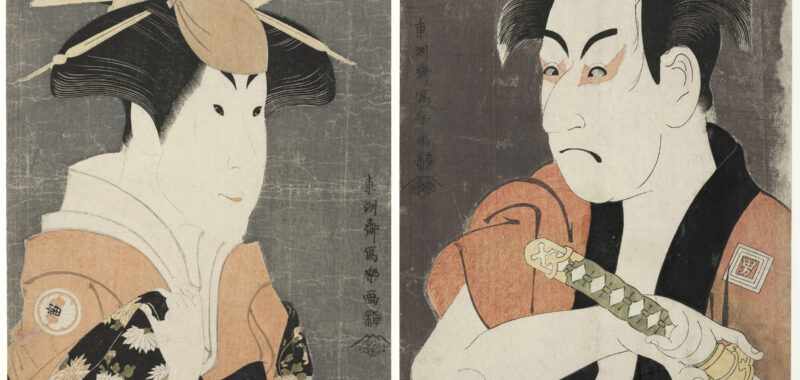CHICAGO — Over the span of merely 10 months in the Edo period, a Japanese artist who went by Tōshūsai Sharaku created almost 150 ukiyo-e prints of actors in kabuki theater, a traditional form of Japanese classic performance. Many are now understood as masterworks of the genre, exemplifying the height of drama displayed by their subjects, with their balanced but delightfully exaggerated forms. They’ve inspired art lovers and historians alike for generations. And yet, no one is quite sure who this artist was.
An exhibition on view at the Art Institute of Chicago (AIC) through October 14 is a rare display of over 30 works by the mysterious artist. Some believe he was an actor himself, but in the more subtle noh tradition, an older art form in which characters wear smooth carved masks and perform distinctly monotonous music and chanting. Perhaps his vantage point on the slow moving noh-stage gave him enough critical distance to perfectly capture action-packed kabuki performances in the woodblock printing form. But since artists often went by pseudonyms — and also changed them, sometimes quite often — his identity remains as enigmatic as the reason his prolific output screeched to a halt so soon after he began.

There are precious few copies of Sharaku’s woodblock prints, so it’s an uncommon treat to see this many on display. “A print can be shown for a period of three months every five years,” the show’s curator, Janice Katz, said in an interview with Hyperallergic. “And if a work of art is lent to a major special exhibition (usually in Japan)” — a common occurrence with Sharaku’s incredibly valuable pieces — “it can’t be shown again here for about 10 years,” Katz clarified, citing conservation standards for prints on paper.
The world of ukiyo-e exploded in the 1760s, when the multi-color printing technique was perfected during a particularly peaceful moment in Japan’s history. These vibrant prints often depicted courtesans and actors from the colorful “pleasure districts,” and were widely available to be purchased not only by members of high society but also by less well-off individuals in the strictly regulated class hierarchy. Sharaku’s 1794 depiction of kabuki actor Ōtani Oniji III playing the evil Edobei in a play titled The Loved Wife’s Parti-Colored Reins remains an icon of the ukiyo-e print genre, beloved for its subject’s outrageously wicked scowl and twitching fingers, poised to steal another character’s money. Prized for capturing the most dramatic moments in kabuki theater, they make perfect introductions to the colorful world of ukiyo-e, which many scholars see as an ancestor of anime and manga due to its outlined figures, intense drama, and relative accessibility.

Katz notes that many of Sharaku’s works are “kind of caricatures — the artist overemphasized the subjects’ facial expression, highlighting the appeal of the Kabuki theater.” Yet, while they may look exaggerated, they also reveal a kind of raw realism.
“It sort of pulls away the veil,” Katz said. “It’s like actually watching a kabuki performance, because you see that these are male actors playing female roles. Other artists would show men in female roles as really graceful, kind of looking like women. And he doesn’t do that.”
Sharaku’s works are unique in that his prints, with imagery many saw as fairly lowbrow, were produced as luxury items. The printer employed expensive materials, spreading shimmering crushed mica across the works’ deep gray backgrounds. This attempt to cater to wealthier classes may have spelled his downfall as an artist in the Edo period: The prints were at once too caricaturish for the more refined tastes of the upper classes and too expensive for everyone else.
But this very quality also played to their popularity among well-moneyed Western collectors, who preferred his raucous style and brought them to institutions like AIC. Now, his vivid scenes are drawing museum visitors into a dimly lit hallway to delight in the ukiyo-e genre, many for the first time. In Katz’s words, “His work just doesn’t look like anything else.”



